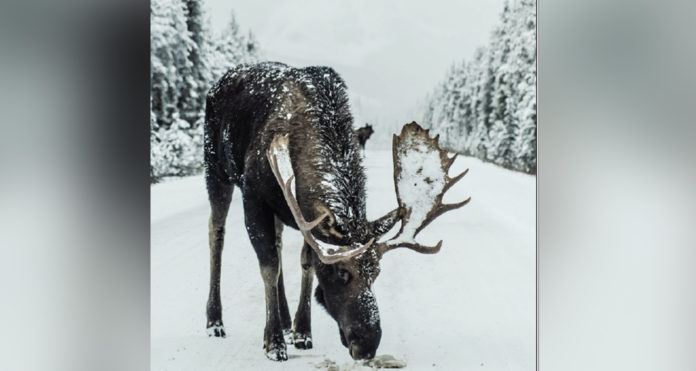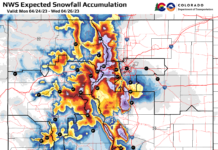by Marissa Lorenz
Grand County recently received a $10,000 payment from a so-called Samson fine, a payment imposed on convicted poachers of trophy big game in Colorado for the last 23 years. And at a recent meeting, the Grand County Board of County Commissioners (BOCC) approved that the payment go back to Colorado Parks and Wildlife (CPW) in the form of the purchase of tasers for CPW wildlife officers.
According to Jeromy Huntington, Hot Sulphur Springs Area Wildlife Manager, a call came in on September 9, 2020, through CPW’s Operation Game Thief, a state program that pays citizens for reporting poaching activity. That call reported a bull moose carcass found outside of Fraser, near the border of Devil’s Thumb Ranch.
The head and antlers of a bull moose were found outside of any legal moose hunting season, but the reporting party stated that the meat was missing, raising suspicions about the legality of the harvest. Most hunters will take the skull and antlers of a legal kill, explains Huntington.
CPW wildlife personnel responded to the scene and questioned parties in a nearby hunting camp. Members of that party reported an individual who had claimed to have legally harvested a cow elk, field dressed it by himself and then asked other members of the party to help pack out the meat. Other campers reported having done so but having felt reticent about the hunter’s unwillingness to indicate the exact location of the take.
Upon investigation, CPW officers found an arrow next to the site of the moose carcass which the hunting party confirmed as being similar to those used by Steve Aragona, a non-resident hunter from Oklahoma, who had already left the camp and, ultimately, the state.
Huntington then describes an interstate investigation in cooperation with game wardens from the Oklahoma Department of Wildlife Conservation.
“We had a bull moose with an arrow found nearby that matched those of the hunting party, Steve Aragona,” describes Huntington. Oklahoma officers obtained a search warrant and, during the interview process, the defendant claimed to have mistakenly shot a bull moose while hunting in Colorado. But regardless of intent, he made the clear choice to conceal the facts from the authorities and from the rest of his hunting party.
CPW gave Aragona a warning for unlawful take of a bull moose without a proper and valid license. But they brought full charges against him for unlawful hunting of a big game animal without a valid license, unlawful hunting outside of an established season, unlawful hunting without a proper hunter’s education certificate, and unlawful possession of a trophy bull moose, which latter charge comes with the mandatory $10,000 Samson surcharge.
“If he honestly thought that it was a mistaken kill and had turned himself in,” Huntington explains, “he would have been looking at a $500 to $1,000 citation. Instead he paid a total of $18,327.85 in fines and surcharges, including a 37% victim’s assistance surcharge.”
The defendant Steve Aragona ultimately paid the entire amount “in the field,” or at the time of citation, and the case never did go through the Grand County courts. “It is the equivalent of agreeing to a plea bargain,” says Huntington. “The suspect pleads guilty to all charges and pays the fines and fees.”The CPW Area Wildlife Manager goes on to explain the Samson surcharge as one that dates back to 1995 when a 1,000-pound, seven-by-nine point bull elk, who had become known as an Estes Park local, was poached just outside of YMCA of the Rockies.
Following a nationwide outcry over the killing, that poacher was convicted of willful destruction of wildlife; sentenced to 90 days in jail, six years probation, and 60 hours of community service; charged $8,200 in fines and court costs; lost his driving privileges for two years; and was prevented from owning any weapons.
Two years later, in April 1998, Colorado’s Samson’s Law was enacted, commanding a $10,000 fine for each conviction that goes back to the county in which the violation was committed. In 2020 the law was amended, changing the statute language from “shall” charge the $10,000 to “may” charge the fee, permitting discretionary decision-making to charging officers.
In Grand County, Samson dollars have traditionally gone back to the Colorado Parks and Wildlife in the form of law enforcement equipment purchased by the County. In line with this, the most recent monies were approved by the BOCC to pay for six tasers with holsters and training cartridges for area CPW officers.
Huntington notes that tasers have become a standard piece of equipment for wildlife officers, who are fully sworn state law enforcement officers. He says that, while they were initially adopted for use with wildlife, park rangers started reporting a growing need for effective tools in law enforcement encounters.
Now, CPW follows a policy for taser use that is modeled after that of Colorado sheriff’s departments and Colorado State Patrol. All state wildlife officers go through annual training and certification in order to develop and maintain familiarity and safe practice with the tools.
To learn more about Colorado Parks and Wildlife and its services and responsibilities, go to cpw.state.co.us.









